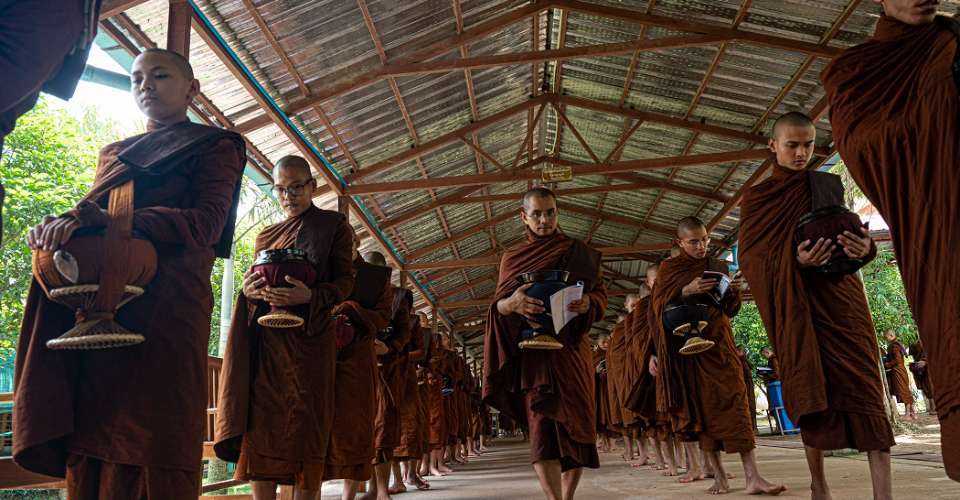
Buddhist novice monks line up for lunch alms at a monastery in Yangon on July 13, 2023. Myanmar’s military regime has ordered a probe into the death of a senior monk after a video contradicted claims he was caught in the crossfire of a battle between troops and rebels on June 19, 2024. (Photo: AFP)
Myanmar’s military regime has ordered an investigation into the death of a senior monk after video evidence was produced online, which contradicted earlier claims he was caught in the crossfire of a battle between junta troops and the People's Defence Force (PDF).
Sayadaw Bhaddanta Munindabhivamsa, a 78-year-old abbot from the Win Neinmitayon Monastery in the Bago region, was shot and killed June 19 while driving out of Mandalay International Airport, which was initially blamed on a firefight by broadcaster MRTV.
Samgha Samagga, a Mandalay-based association, condemned the killing, saying in a statement his death was an act of terrorism after another monk, Sayadaw Bhaddanta Gunikabhivamsa, who was in the car at the time, claimed he was killed by junta troops who opened fire from a truck.
A video began circulating on social media the following day, in which Gunikabhivamsa said he was injured alongside the driver by indiscriminate shooting by junta forces. Soldiers claimed they believed the car was an enemy vehicle because the windows were closed.
That prompted a senior junta official to visit the Win Neinmitayon Monastery on June 21. The official later said the initial information about the firefight was incorrect, the incident would be investigated, and the junta would respond accordingly.
“The military has apologized and promised to investigate to find out what happened,” a PDF source told UCA News. “But the reality is they had no choice given what happened.”
The source said soldiers opened fire from the truck, but they didn’t reckon on how senior the monks inside the vehicle were, adding Munindabhivamsa was from the Samgha Samagga. He was among the highest Buddhist officials in Myanmar.
“There were three people in the car, two monks and one driver, and the military hit the car from the truck, and when they got in closer, Munindabhivamsa was already dead. The driver lost three fingers, while Gunikabhivamsa sustained head injuries from the broken glass.
“Gunikabhivamsa confronted soldiers who took their phones away because they were frightened about what they had done. Then, soldiers from another department arrived and began interrogating the survivors.
“They were taken to Mandalay Palace, where a military camp is based, and were interrogated for five hours, and Gunikabhivamsa was denied medical treatment for his head injuries,” the source said, adding the video began circulating. Gunikabhivamsa later went on television explaining what happened.
Junta spokesman Major General Zaw Min Tun then admitted regime troops were responsible but insisted his security forces ordered the vehicle to pull over and had fired warning shots. It was only then that his “security personnel opened fire on the moving vehicle from behind.”
The PDF source said the military had had little choice but to apologize.
“The military can’t hide that news anymore, so Zaw Min Tun had to apologize. But there’s also a bigger problem. We have long suspected the military of killing religious figures and blaming it on the revolutionaries because they want to start a religious conflict,” she said.
“They want to blame us for killing monks and turn the Buddhist hierarchy against us.”
A similar claim was made last year when a fourth massacre in less than a month resulted in the deaths of 29 civilians, including three monks.
Zaw Min Tun had initially blamed the March 16 massacre on Karen ethnic forces aligned with the PDF a charge denied by its political umbrella, the exiled National Unity Government, which said the claim was part an attempt to turn the Buddhist clergy against those opposed to the junta.
An investigation by Karenni State Police found 5.51mm bullets fabricated in 2022 had been fired from automatic rifles during the slaughter.
“This type of bullet is only used by the military,” their report added.
The military then justified the killing of the monks by claiming they were members of the PDF.
Munindabhivamsa’s body is currently lying in state at the Win Neinmitayon Monastery, where mourners are paying their respects.


